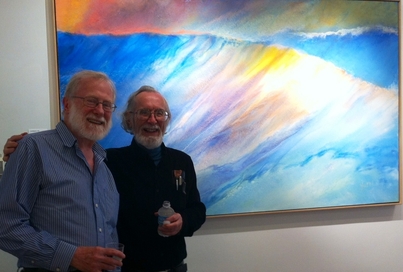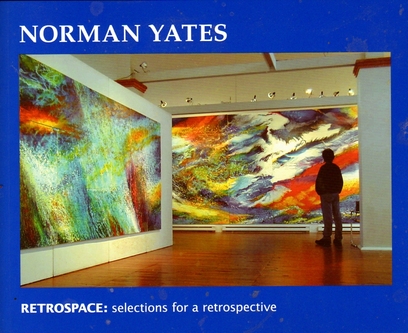
Norman had served overseas during the war in the Royal Canadian Air Force as a radar operator. He had graduated from the Ontario College of Art in 1950 and begun teaching at the University of Alberta a few years later. He and I were the grandchildren of sisters, born in Sunderland, County Durham. The younger, born 1882, had immigrated to Vancouver in 1913 and the older, born 1870, to Calgary in 1926, but they had never attempted to visit one other. Postal contact between them and their families ended when the older sister died in 1953, predeceased by her daughter, Norman’s mother, in 1948.
Norman died last week, most unexpectedly, at the age of 90. He had been still painting large canvases; his art had been still evolving. Openness to such change was one of the two major things I had discovered that we shared – we both believed that our new work should be a significant step from our previous work. The other was that we both believed that composing involved collaborating with one’s materials. In his case this had come to mean – by the time I

Some of the large work I saw there was only a part of larger creations. Norman had begun specializing early in his career in works that were made up of multiple panels, and were up to five or six metres in length. His largest was probably West and North, at 20 x 42 metres, installed in 202 panels on side of the University of Alberta Faculty of Education building in 1987. Many of his paintings after he had retired to Victoria were similar commissions for interior walls of large buildings. Apart from the National Gallery, his work is mainly in western Canadian collections, including the Edmonton and Vancouver galleries. Paintings are much more difficult to circulate than books – especially ones of the size that he tended to produce -- although at the time of his death he was represented both by Virginia Christopher Fine Art in Calgary and Patrick International Fine Art in Toronto.
I reserved a day to visit Norman whenever my own work took me to Victoria over the last two decades. He was my special cousin, always energetic, cheerful and optimistic, always working on new projects and always with a new discovery about his art that he was eager to show and explain. Artists often feel a little different from the others in their families. It was curiously grounding for me to have a second cousin with whom I could talk about ‘work,’ and who also knew many of the writers I had shared projects with – knew both their work and lives. I will miss my special cousin enormously – but he will always have been.
FD
 RSS Feed
RSS Feed